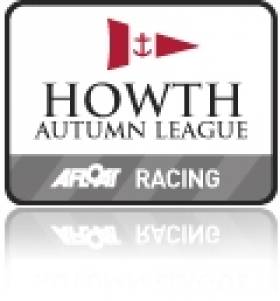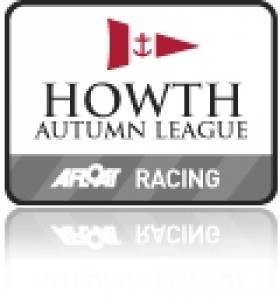Displaying items by tag: White Sail Cruisers
Another large entry expected for WD-40 Autumn League at Howth
Howth Yacht Club’s ever-popular 6-race Autumn League, which will attract over 130 entries in 11 classes, starts next Sunday (25th September), with Team PR Reilly as the title sponsor using its WD-40 brand.
Team PR Reilly is Ireland’s largest distributor of motor parts and car accessories and its sponsorship continues a close association with Howth Yacht Club, having supported previous years’ Autumn Leagues with its WD-40 and Green Works brands.
Additional sponsorship will be provided by HB Dennis Airside, the Range Rover, Land Rover and Volvo dealer, who will use the Volvo brand with which it supported the Puppeteer Nationals earlier in the year. Prizes of a number of 1-year Windguru PRO subscriptions have also been offered by Windguru.
Event Chairman, Brian O’Neill said, “We are delighted to receive offers of sponsorship from Team PR Reilly, HB Dennis and Windguru. Their support is crucial to the success of events like this and we truly value that support. The stage is now set for an exciting competition for competitors, club and sponsors alike.”
In a repeat of last year’s successful format, the WD-40 Autumn League will include four Sunday ‘round the cans’ races and culminate with two back-to-back windward-leeward races on Saturday 22nd October. The Sunday start times have been put back by one hour to accommodate competitors wishing to watch Irish World Cup Rugby matches earlier each morning.
The event will again feature a Mini Series for Cruiser classes over the last three weekends to encourage southside entries after the Dublin Bay season ends.
Six one-design classes will be given starts, including the J24 Class just after its BMW European Championships at Howth. The Heineken Trophy will be presented to the best overall winner and the Olympus Trophy will go to the best team of three boats (each boat from a different class) declared before the first race.
Entries can be made online at www.hyc.ie
Exciting action in big winds and seas at Howth Autumn League
As if to confuse all concerned, the conditions encountered for race 4 of the Autumn League sailing were totally at odds with the forecasts being given in the days beforehand. Instead of the predicted balmy day, the fleets faced very fresh north-easterlies and a big sea, both of which had a significant input into the outcome of the day's racing.
Indeed, only a couple of series leaders across the nine classes managed to secure a win yet still retained their top positions with the final two races to go next Saturday morning. It was a day when jammed halyards, torn sails, a few broaches, some rapid downwind speeds, very wet foredeck crew, and even the odd bloodied forehead were to be witnessed.
The Squibs made a collective decision that their small craft might have some problems with such a large swell and opted for a civilised class breakfast instead. Some of those who sailed may have envied that option but the reaction was generally one of satisfaction in mastering the conditions over a two-hour period.
'Crazy Horse' (Chambers/Reilly) again took line honours in Class 1 but had to settle for 2nd on IRC while series leader 'Storm' (Pat Kelly) emerged as race winner on both handicaps. That 'double' secures a double overall lead, albeit only by two points on IRC and tying with 'Equinox' on ECHO.
The conditions were never going to favour Class 2 leader 'Kinetic' (Colwell/Murphy) and so it proved, yet 4th equal with main rival 'King One' (Dave Cullen) is hardly a disaster and doesn't alter their place at the top of the table. The 'twins' 'Xebec' and 'Dux' however revelled in the big seas and finished in that order on IRC, with 'Xebec' (with Francis Ennis on helm) also taking the ECHO honours. 'Kinetic' still heads both handicap tables but only by two points in each case, ahead of 'King One' and 'Maximus' respectively.
For the second week in a row, Vincent Gaffney's 'Alliance' didn't notch a win in Class 3, finishing second just behind 'Starlet' (E.Bourke) but it didn't adversely affect the overall position on IRC, with 'Alliance's' cause greatly helped by rival 'Gecko' (Kevin Darmody) having their worst result of the series. Malahide visitor 'Tobago' (Ray & Others) had a good day, winning on ECHO ahead of clubmate 'Shenanigans' (Douglas/Keane) to leapfrog over 'Rossinver' (C.Scott) to lead overall.
Class 4 leader 'On the Rox' (C&J Boyle) didn't finish the race so it becomes their discard and they still lead the fleet on ECHO but only by a single point from 'Bite the Bullet' (Colm Bermingham) who finished second in the fourth race behind 'FanatiX' (R. Fanning). 'Flashback' (Hogg et al) had a good day last Sunday and they followed it up with another, winning on IRC by a comfortable margin to stay ahead of 'Bite the Bullet' in the overall standings.
As the smallest boat in Class 5, 'Demelza' (Ennis/Laudan) was always going to struggle in the heavy conditions against much bigger boats and a 7th place confirmed that prediction but, allowing for a discard, the Shamrock still leads the field by two points from Denis Toomey's 'Harmony'. Andrew Knowles' 'Sandpiper' had a memorable day, winning on both handicaps, and now moves to 3rd overall on ECHO, while there's a tie for first on IRC between 'Alphida' (Harry Byrne) and 'Voyager' (Joe Carton).
The only non-HYC entry in the Etchells, Jay Bourke from the Royal St.George YC, in 'Northside Dragon' again showed the way, taking the gun just less than 30 seconds ahead of 'Jabberwocky' (Simon Knowles), a result which is mirrored in the overall standings too.
In the J/24s, national champion Flor O'Driscoll (who missed a couple of races, partly because of All-Ireland Championship duty) came back to fill his customary position but was pressured throughout by 'Jibberish' (Fergus O'Kelly & others) and in the end only 5 seconds separated them on the line. The Howth boat still leads overall by three points over 'Scandal' with O'Driscoll and crew only point adrift in third spot.
There was yet another new race winner in the Puppeteers, this time in the shape of 'Gold Dust' (Walls & Browne), 15 seconds clear of series leader 'Harlequin' (Clarke & Egan) and Alan Pearson's 'Trick or Treat' a further 15 seconds back. The result had the added bonus of moving 'Gold Dust' up to equal 2nd with Neil Murphy's Yellow Peril, while a handicap win for 'Gepetto' (Edward O'Reilly) jumps them ahead of 'Ghosty Ned' (Donal Harkin) on the HPH leaderboard.
Roddy Cooper's delight in steering 'Leila' to victory by a minute ahead of Ian Malcolm's 'Aura' was, it appears, short-lived. He was subsequently disqualified for not passing the Spit mark correctly so 'Aura' got the win on scratch and handicap ahead of 'Oona' (Peter Courtney) and 'Sheila' (Derek Bothwell) respectively. It means the Malcolm crew narrow the gap at the top behind series leader 'Rita' (Lynch/Curley) to one point and assume the HPH lead by two points over 'Sheila'.
The 2010 Autumn League, sponsored by WD-40, Crystal Holidays and The Food Room, concludes next Saturday 16th with two back-to-back races over windward-leeward courses to complete a six-race series.






























































